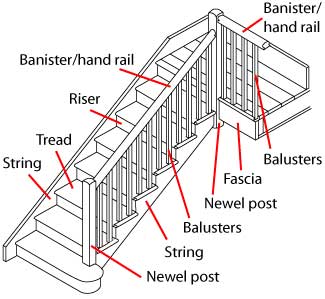Painting a staircase

Before you start painting a staircase, remove the stair carpet and any underlay. Brush all the dirt off of the stairs – considerable amounts will have collected under the carpet and must be cleaned off so that it does not get into the paint. Using a hose vacuum cleaner with a brush attachment will pick up the dust very effectively.
There is generally no need to remove any carpet grippers fixed to the stairs as modern type are normally hidden under the carpet, they leaving them in place can make cleaning off all the dirt awkward.
A staircase can often be more attractive if the banisters and/or balusters are varnished while the treads, risers and strings are painted. Any parts to be varnished should be completed before any part painted, the basic procedure is the same as painting, i.e. varnish downwards, doing the banister first and, if appropriate, the balusters underneath. Care needs to be taken to avoid and splashes of painting getting onto the varnish when the other parts are being painted.
If the banister and/or balusters were originally painted, all traces of old paint needs to be removed before varnishing, carefully using a hot air gun or a chemical stripper; but a word of warning, the timber used on originally painted stair parts is often of poorer quality than that used parts originally covered with a clear finish, so you might be disappointed with the finished appearance after stripping off the paint.
Check each step for loose or damaged treads and risers, repair them if necessary. Prepare the surfaces:
- if the existing paint is sound, use sandpaper to remove the gloss.
- if the paint is flaking or chipped in places, sand smooth then touch up with primer and undercoat if necessary (depending on the type of top coat being used).
When painting a staircase, always apply thin coats of paint, so that it does not run on the vertical surfaces. Starting by painting the banisters, newel post and balusters first; then, working from the top of the stairs, painting each step (tread, riser and string). Leaving any painting of wood beside the stairs until last.
Use different sized brushes for the different parts being painted; for example, use a larger brush for painting the risers and treads, and a smaller brush when painting the balusters.
Lightly rub down the banister between paint coats with a very fine grade abrasive paper to achieve a really smooth finish which will be pleasing under your hand.
If a stair carpet is going to be laid, there is no need to paint the full width of the stair, the paint should extend about 50mm (2 inches) under each side of the carpet.
